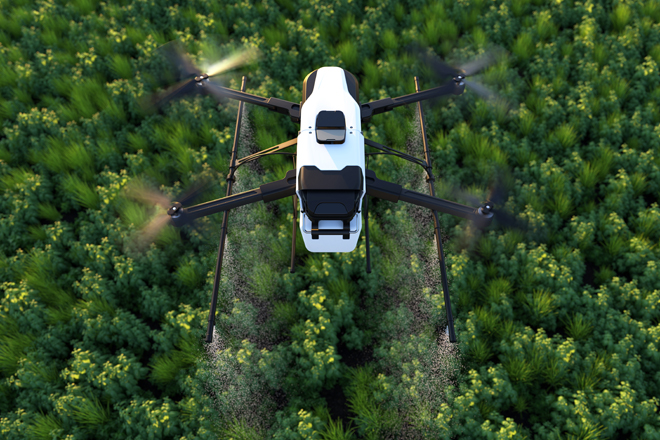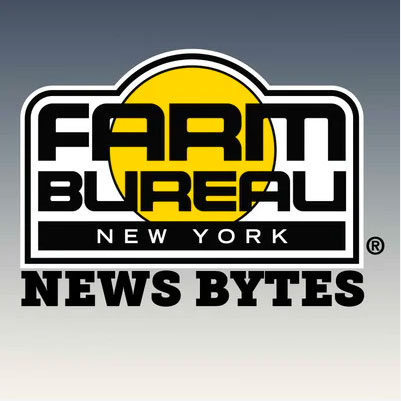Eight Uses for Drones For Farms of All Sizes
‘Precision Agriculture’ Better Informs Farmers and Offers a Wide Variety of Usages
NYFB Content Creator
The use of drones in nearly every sector of the economy is on the rise, but drone usage in the agricultural industry is surging. According to a report by Markets and Markets, the agricultural drone market is projected to increase from a $1.2 billion in 2019 to $4.8 billion in 2024. From scouting to security, drone use will become m ore omnipresent on large and small-scale farms in the near future. The data supplied by drones on farms is frequently used to better inform important decisions and is part of a technique referred to as ‘precision agriculture’.
ore omnipresent on large and small-scale farms in the near future. The data supplied by drones on farms is frequently used to better inform important decisions and is part of a technique referred to as ‘precision agriculture’.
Here are eight ways that drones are being used on the farm right now:
1.) Livestock Monitoring – The incredible thing about drones is the birds eye view that they can provide. If you have never seen your farm from 300 feet up, it is quite an experience and can offer valuable insight into your business. Using a drone with a thermal sensor can let you pop your drone up in the middle of the night and count your cows in the dark. Once they are all accounted for and you can have a good night’s sleep.
2.) Farm Security – Whether you have a large farm or a small ranch you are always on the look out for predators. By sending your drone on patrol it’s possible to see if there are visitors (human or animal) on your property that are not supposed to be there. By using your drone as security, you keep yourself out of trouble allowing you to call the authorities if you spot an intruder. Some drones even have speakers to broadcast your voice to anyone in the vicinity.
3.) Condition Monitoring –When conditions are wet and muddy, no one wants to take the giant sprayer or tractor out to potentially get stuck in the mud, destroying crops that don’t need to be destroyed. Drones are a cheap and efficient way for you to monitor your field conditions and gauge the condition of the land avoiding hazardous or costly errors.
4.) Beneficial Bugs - Between new regulations and insect resistance, ensuring the crop is safe from damage can be difficult and stressful. Beneficial insects seem like a good idea, but the cost and labor management involved makes them less appealing. How do you deliver these needed insects to fight infestations and keep your crops healthy? Drones to the rescue! Companies like Parabug can cover as much as 300-500 acres in a day with the added benefit being able to access fields in wet conditions as well as providing more uniform coverage than traditional hand applications.
5.) Cross Pollination- Working with hybrid corn can be tricky. The usual way to maximize yield is to plant one row of male corn and three or four rows of female corn. The farmer relies on the wind to blow and assist with the pollination. Because there is a limited window of time this can happen, hoping that the wind will blow can be very stressful. By utilizing a larger drone with a large amount of downward thrust, a farmer can fly low over his field creating his own wind and helping to reduce the reliance on mother nature.
6.) Mapping – Digital mapping gives you better insight into your crops from above and serves as the foundation for your groundwork. RGB maps are regular color maps (think highly detailed google maps). Thermal maps give you accurate temperature readings of the crops, and multi spectral imaging allows detection of subtle variations in plant health before visible symptoms appear. A grower can spot a small reduction in a plant’s chlorophyll content before the leaves start to turn yellow.
7.) Seeding – As bigger and more versatile drones make their way on to the consumer market, tasks like seeding fields are being handed to drones. Hard to reach fields, muddy conditions, or rough terrain can be easily seeded and fertilized quickly and efficiently. The DJI Agras T30 can spread solid dry particles with a diameter of 0.5-5 mm to a width of up to seven meters, and an hourly spreading capacity of one ton. These drones not only can provide seeding services but can be easily adapted to spraying as well.
8.) Spraying - The ability to automate the dispersal of agrochemicals with a high degree of accuracy is a huge step in digitizing agriculture and smarter farming. The latest drones offer a 40kg capacity with a 50kg per minute flow rate. That equates to potential coverage of 40 acres per hour, and an enormous productivity boost for a usually manual task that demands fast and accurate distribution.
One important aspect to note is this type of drone application of pesticides requires a 14 CFR Part 137, which is a specialized FAA certification dealing specifically with agricultural aircraft operations. According to pilotinstitute.com, as of February 2021, only 37 companies in the US have received Part 137 certification.
Certification
A farmer looking to use a drone for their farming operations or any business related work must have a Part 107 license. The FAA Part 107 is a set of rules for operating drones for any sort of monetary gain, direct or indirect. Drone application of pesticides requires a 14 CFR Part 137, which is a specialized FAA certification dealing specifically with agricultural aircraft operations. According to pilotinstitute.com, as of February 2021, only 37 companies in the US have received Part 137 certification. For those looking to dive deeply into the world of agriculture drones, please visit the FAA website for more information.
The Future
In Japan, scientists have designed insect-size drones capable of pollinating flowers in the same manner as bees. The drones use GPS to select the optimal flight path for pollinating nearby plants. In Canada, drones using a pressurized air cannon and small seed pods, have been used for planting trees. The group predicts a single operator would be able to plant 100,000 seed pods per day.
The agricultural world is just scratching the surface of what drones can offer. As research continues and engineers find new ways to incorporate aerial data collection into farming operations, we are likely to see considerable advances in crop production.
With low barriers to entry, and the promise of greater efficiencies, it will soon be difficult to imagine successful operations without drones.



